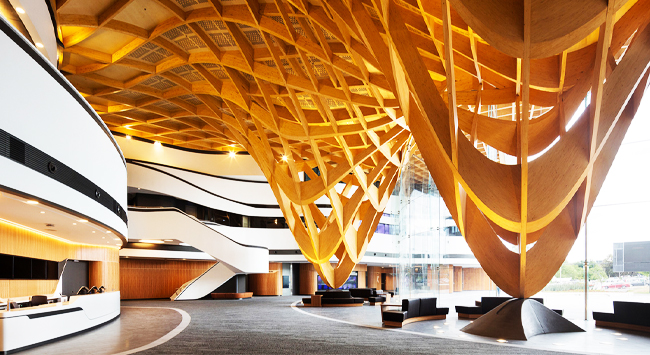Saturday, May 18, 2024
|
Listen to this news
|

The lumber industry has increasingly embraced sustainable and innovative building techniques. Over the past decade, Mass Timber has surged in popularity, significantly impacting the future of traditional materials like concrete and steel.
Let’s have a quick glance on Mass Timber
Mass timber differs significantly from ordinary dimensional lumber. It consists of large engineered wood panels that are compressed to create a strong, load-bearing building material. Various types of mass timber products include cross-laminated timber (CLT), glued laminated timber (glulam), nail-laminated timber (NLT), dowel-laminated timber (DLT), mass plywood panels (MPP), laminated veneer lumber (LVL), parallel strand lumber (PSL), and laminated strand lumber (LSL). Each type offers unique functionality and appearance, catering to different construction needs and aesthetic preferences.
Understanding mass timber
Mass timber is an umbrella term for engineered wood products consisting of large, solid wood panels created by stacking multiple layers of lumber boards and bonding them with glue or fasteners. This manufacturing process produces strong and stable building materials suitable for a wide range of applications.
Different kinds of mass timber available:
Cross-laminated timber (CLT): Composed of layers of lumber boards stacked at right angles, generally used for walls, floors, and roods in modern buildings.
Laminated strand lumber (LSL): It is a generally durable engineered wood product made from strands of wood fiber compressed and bonded together.
Laminated veneer lumber (LVL): An engineered wood product manufactured by layering thin wood veneers and gluing them together.
Nail Laminated timber (NLT): A cost-effective mass timber product made by fastening dimensional lumber with nails.
Glue-laminated timber (GLT): An engineered wood product made from long strands of wood aligned in paralleled and bonded together.
Is mass timber better than concrete and steel?
While concrete and steel remain popular building materials, mass timber offers a compelling alternative with notable advantages in sustainability, structural performance, design flexibility, and construction efficiency. The debate between mass timber and traditional materials like concrete and steel hinges on several key factors.
Environmental impact of mass timber in society
One of the key drivers behind the rising popularity of mass timber is its environmental performance. Unlike concrete and steel, the production of mass timber generates significantly lower carbon emissions, making it a more sustainable choice. Trees capture carbon dioxide during their growth, which is then stored within the mass timber products, acting as a carbon sink and helping to mitigate climate change.
Mass timber is sourced from responsibly managed forests, promoting sustainable forestry practices and supporting global reforestation efforts. As consumers increasingly prioritise eco-friendly alternatives, mass timber is the choice for environmentally conscious buildings.
Read more news on: Mass timber, sustainable, wood product, lumber
Get more updates on American woodworking industry through: www.woodandpanel.us
Tags: engineered wood products, lumber marketing, mass timber, plywood, sustainable, wood, wood and panel, wood products, woodworking, woodworking industry
Comments: